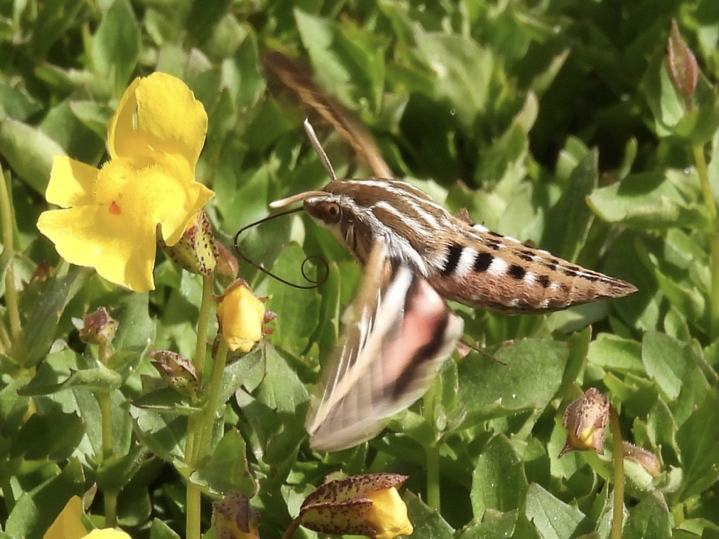Moths and butterflies together make up one of the largest groups of animals – at least 160,000 species worldwide. Only one in 10 of these is what we call a butterfly; the other 90% we call moths.
Although there are exceptions, most moths are nocturnal and therefore drab, and many are small; butterflies are day-flyers, colorful, graceful in flight and often fairly large. Compare many moths to butterflies – certainly the most charismatic of our Garden insects – and the former don’t stand a chance in a popularity contest. And yet, entomologists consider butterflies as essentially representing a lineage of “brightly-colored day-flying moths.” Evolutionarily speaking, butterflies are really … moths! For photos and more detailed information about butterflies in particular, see Butterflies in the Garden.
Probably the easiest and (usually) most reliable characteristic that distinguishes adult butterflies from moths is the shape of the antennae: butterfly antennae are long and thin with a club (or hook) at the end; moth antennae are more variable, and can be straight or sometimes very feathery, but usually without a club. In many moth species, the male’s antennae are feathery while the female’s antennae are more threadlike. This difference between the sexes is not seen in the butterflies.
Habits and ecological importance
With very few exceptions (think: clothes moth), moth and butterfly larvae (caterpillars) are plant-feeders, chewing their way through leaves, stems, roots, flowers or seeds. The vast majority of species specialize as larvae on one or a very few closely related plants; the term host plant refers only to the caterpillar’s (not the adult’s) food. Important examples of host plant specialization in the Garden are California pipevine swallowtail (Battus philenor hirsuta) caterpillars on California pipevine (Aristolochia californica) and monarch (Danaus plexippus) caterpillars on showy milkweed (Asclepias speciosa).
A pupa is the non-feeding stage between caterpillar and adult. The moth pupa generally takes cover underground, in a leaf shelter, or in a silk cocoon. The butterfly pupa (chrysalis) is hard-shelled, often colorful and attaches to a plant or other outdoor surface.
Adults feed mostly on nectar with a long tongue (proboscis) that they keep compactly coiled when not feeding. Unlike their caterpillar stages, adults tend not to specialize on a particular plant group – although, like many flower-visitng animals, they may prefer certain flowers or flower characteristics. Nectar plants should not be confused with or referred to as host plants. For an adult moth or butterfly, a nectar plant provides food; a host plant, in contrast, is a plant on or near which to lay eggs.
As they visit flowers for nectar, adults may, by chance, also transfer pollen. As pollinators, butterflies are not generally very efficient, moths are considered important pollinators, especially of night-blooming plants.
Because of their diversity and abundance, moths (including butterflies) are among the most important insect groups on Earth. They and their caterpillars are thought to transfer more energy from plants to other organisms than any other kind of herbivore. This makes them ecologically indispensable across many habitats. For gardeners, including caterpillar host plants – mostly natives – in addition to nectar plants has become an essential part of the “habitat garden.”
Some Moth Species and Associated Plants
In the Bay Area, oakmoth larvae (Phryganidia californica) feed largely on coast live oak (Quercus agrifolia). In most years populations are small and scattered, but occasional outbreaks can lead to defoliation by late summer or fall. Healthy trees generally tolerate extensive loss of leaves without serious harm.
Oakmoths are “typical” moths”: drably colored; antennae threadlike or feathery, depending on sex; wings held horizontally over the back at rest.
Moths and Butterflies
With common names such as sphinx moths, hawk moths, and hummingbird moths, many of these strong flying moths in the family Sphingidae are considered primary pollinators for hundreds of plants.
The white-lined sphinx moth (Hyles lineata) is a large, day-flying, colorful moth that is occasionally seen in the Garden and puts the lie to the notion of the “typical” moth. Shown here, it approaches a flower while it uncoils its tongue to feed (John Aull, iNaturalist).
Leaf mining is one of the more interesting habits of some moths (as well as other types of insects). An egg is laid in or on the leaf; when larvae hatch they create a tell-tale, widening trail as they feed and travel between the epidermal layers of the leaf. Miners may spend their entire life cycle within leaf tissues, emerging as adults; in some species larvae emerge from the mine to pupate in the soil.
Madrone skin miners (Marmara arbutiella) feed within leaves of madrones (shown here) and manzanitas, leaving squiggly lines as they feed (iNaturalist).





